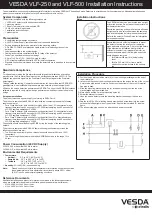
55
responsive to ethanol than to methane, so the readings
will be low. Multiplying the instrument reading by the
correction factor for ethanol will produce the true
concentration.
Given that the correction factor for ethanol is 1.2, if the
instrument reading is 40 percent LEL, then the true
concentration is seen to be about 48% LEL.
(40 % LEL) X (1.2) = 48% LEL)
Instrument Correction Actual
Reading Factor Concentration
It is important to note that the correction factor for ethanol
is different when the instrument is calibrated on propane.
In the case of a propane calibrated instrument,
instrument readings for ethanol will be high. Given that
the correction factor for ethanol in this case is 0.76; when
the instrument reads 40 percent LEL, the true
concentration for ethanol is 30% LEL.
(40 % LEL) X (.76) = (30% LEL)
Instrument Correction Actual
Reading Factor Concentration
2. Effects of contaminants on combustible sensors
Combustible sensors may be affected by exposure to
silicone containing substances (found in many lubricants
and hydraulic fluids), the tetra-ethyl-lead in "leaded"
gasoline, and halogenated hydrocarbons (Freons
£
, or
solvents such as trichloroethylene and methylene
chloride). High concentrations of hydrogen sulfide may
also damage the sensor.
If sensitivity of the combustible sensor is lost due to
poisoning, it tends to be lost first with regards to
methane!
A partially poisoned sensor might still respond accurately
to propane while showing a dangerously reduced
response to methane.
2.3. Choosing the right calibration gas for
combustible sensors
The best results are obtained when calibration is done
using the same gas that is expected to be encountered
while actually using the instrument. When not sure what
combustible gases might be encountered, it is important
to choose a calibration gas that will provide a level of
sensitivity which is typical of the widest range of
combustible gases.
Propane provides a sensor response which is more
typical of the wide range of combustible gases and
vapors than any other calibration mixture. The only
drawback to using propane based calibration gas
mixtures is that a partially poisoned sensor might still
respond accurately to propane while showing a
dangerously reduced response to methane.
Use of Biosystems’ “Propane Equivalent” calibration
mixtures guards against this potentially dangerous sort of
calibration error.
Biosystems’ “Propane Equivalent” calibration mixtures
are based on methane, but in concentrations which are
designed to produce a level of sensitivity “equivalent” to
that provided by a mixture which contains a 50% LEL
concentration of propane. Because Biosystems’
equivalent mixtures are based on methane, any loss of
sensitivity to methane is detected (and can be corrected)
immediately.
Use of other gases such as pentane or hexane to
calibrate the instrument should be reserved for situations
where these are either the gases predominantly present,
or where the relative response to the calibration gas
closely approximates that of the actual gas to be
measured.
Verifying accuracy before each day’s use insures that
proper sensitivity is maintained over the life of the
combustible sensor.
3. Toxic gas alarms
The PhD Ultra has three separate alarm points for toxic
gases: Ceiling, STEL, and TWA.
OSHA has assigned some, but not all, toxic substances
with a ceiling or "Peak" exposure level. This is the
highest concentration of a toxic substance to which an
unprotected worker should ever be exposed, even for a
very short time. Never enter an environment even
momentarily when concentrations of toxic substances
exceed the ceiling level.
The Time Weighted Average ( or TWA) is the maximum
average concentration to which an unprotected worker
may be exposed over an eight hour working day. During
this time, STEL and ceiling concentration limits may not
be exceeded.
OSHA has assigned some, but not all, toxic substances
with a Short Term Exposure Limit. The STEL is the
maximum average concentration to which an unprotected
worker may be exposed in any fifteen minute interval
during the day. During this time, neither the eight hour
TWA or the ceiling concentration may be exceeded. Any
fifteen minute periods in which the average STEL
concentration exceeds the permissible eight hour TWA
must be separated from each other by at least one hour.
A maximum of four of these periods are allowed per eight
hour shift.
The table below shows the highest levels at which these
alarms should be set. If OSHA has not determined a
ceiling value, for greatest safety the PhD Ultra ceiling
alarm should be set at the same value as the STEL
alarm. If OSHA has not determined a STEL value, the
PhD Ultra STEL alarm should be set at the same value
as the TWA.
4. U. S. Department of Labor, Occupational Safety
and Health Administration (OSHA) Permissible
Exposure Limits for select toxic gases:






































